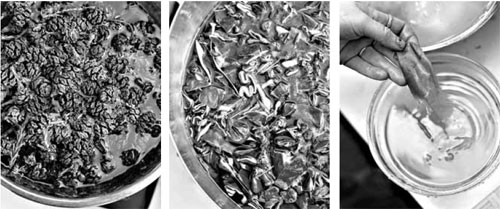Creating lush colors from nature's palette
Updated: 2012-05-13 07:49
By Michael Tortorello(The New York Times)
|
|||||||
|
From far left, redwood cones, cabbage and sour-grass weed take on different hues when mixed with natural ingredients to make dyes. Photographs by Drew Kelly for The New York Times |
The art of natural dyeing has been near dead since the mid-Victorian era. Yet in the experience of Sasha Duerr, a textile design teacher at the California College of the Arts in Oakland, the last two years have seen a bloom of interest in growing botanical dyes.
On a recent afternoon, Ms. Duerr, 36, sparked up three propane camp stoves and scavenged a few things to boil. She intended to show how easy it is to transmute common plants into natural fabric dyes of rare beauty.
The formula has been an open secret since the days of Pliny the Elder: fill a pot with water, add a basket of leaves and a square of silk, bring the potion to a simmer. Then wait for the magic to happen.
"Poppy roots make a yellow-orange," she said. A light green comes from fava bean vines. "You know you can eat the fava leaves, too," Ms. Duerr said.
In Boerum Hill, Brooklyn, a new dye garden and Community Supported Agriculture program will begin this spring in a formerly derelict lot. The Textile Arts Center, which is helping to start the garden, will offer not just plant material, but a workshop and access to its studio.
Natural dyes exist all around us, said Isa Rodrigues, 26, who organizes the center's Sewing Seeds program, yet "people are not aware of them." Colors can come from common flowers (like dahlias and marigolds); tree leaves (Japanese maple, sweet gum); berries (blackberry, elderberry); herbs (mint, rosemary); nuts and shells (acorn, black walnut hulls); and barks (birch, madrone).
In old manuals, you can often spot the traditional dye plants - madder, woad, true indigo - from the word "tinctoria" or "tinctorum" in the botanical nomenclature. Yet Pamela Feldman, 58, has always needed to identify these mysterious specimens for the other community gardeners who share the grounds of the old Chicago Municipal Tuberculosis Sanitarium.
For 17 years, Ms. Feldman has published the Turkey Red Journal (turkeyredjournal.com), a twice-yearly periodical that addresses recondite topics like Japanese mud dyes and Scandinavian mushroom coloring. But most dyers seem to learn through workshops or apprenticeships.
What do artists see in natural dyes? "For me, getting the color is part of the art," Ms. Feldman said of the rugs she weaves. "Otherwise, it's someone else's work."
Ms. Duerr reported that her nonprofit research and education group, the Permacouture Institute, has been swamped by "requests for internships recently," she said. "From Finland, from India." She compares natural dyes to "an heirloom fruit or vegetable."
"It's hard to go back once you've tasted that," she said.
And as with an heirloom tomato, a botanical dye depends on the caprice of the land: the climate, the sunlight, the pH level of the water and the fertility of the soil. The olive fruit Ms. Duerr plucked one November yielded a teal hue. A year later, in February, she said, "I got indigo blue from olives of the same tree."
Natural dyers call this serendipity. Fabric makers call it inconsistency, and they don't like it.
Synthetic dyes were first created in 1856 and proved cheap to manufacture. Within a few decades, natural dyes nearly vanished from the marketplace, said Georgia Kalivas, who teaches in the textile department at the Fashion Institute of Technology in New York. But with synthetic dyes, extra chemicals can trickle into the waste stream. The byproducts of industrial dyeing include aromatic solvents, formaldehyde, chlorine bleach and heavy metal salts, Ms. Kalivas said. The sooner these chemicals go out of fashion, she added, the better.
Ms. Duerr shook a sprinkling of baking soda over a swatch that had been dyed in sour-grass flowers and leaves. This one went from yellow to a 1970s earth tone of coppery orange.
"That color was really in this year," Ms. Duerr said. "All fashion recycles."
The New York Times
(China Daily 05/13/2012 page12)
